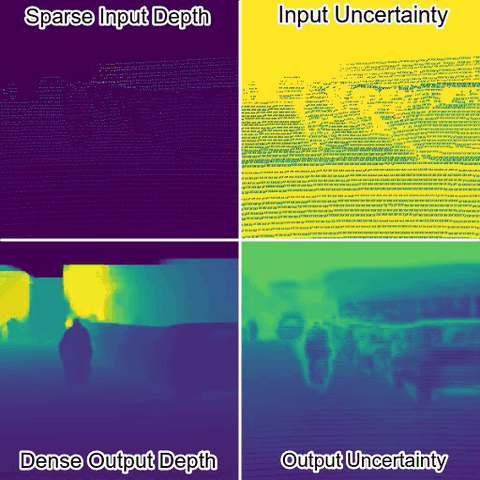Probabilistic Normalized Convolutional Neural Networks (pNCNN)
This is the official PyTorch implementation for "Uncertainty-Aware CNNs for Depth Completion: Uncertainty from Beginning to End" presented at CVPR 2020, Seattle, USA.
[PDF] [ArXiv (With Supplementary)] [1min Video] [[Slides]]
@InProceedings{Eldesokey_2020_CVPR,
author = {Eldesokey, Abdelrahman and Felsberg, Michael and Holmquist, Karl and Persson, Michael},
title = {Uncertainty-Aware CNNs for Depth Completion: Uncertainty from Beginning to End},
booktitle = {IEEE/CVF Conference on Computer Vision and Pattern Recognition (CVPR)},
month = {June},
year = {2020}
}
Dependecies
The code was developed using Python 3.7.4 and PyTorch 1.4, but it should work on any PyTorch version > 1.1
- pytorch>1.1
- torchvision>0.5.0
- json
- matplotlib
- opencv
- h5py
Datasets
Kitti-Depth
To download the Kitti-Depth dataset, use the provided Python script dataloaders/download_kitti_depth_rgb.py.
Remeber to edit the script first to set download directories.
NYU-Depth-v2
Download and extract the dataset in h5 format provided from sparse-to-dense.
wget http://datasets.lids.mit.edu/sparse-to-dense/data/nyudepthv2.tar.gz
tar -xvf nyudepthv2.tar.gz && rm -f nyudepthv2.tar.gz
Training
Experiments are stored in workspace directory, where you can have different workspaces in sub-directories.
To train a new experiment, you should create a new directory with the name of the experiment inside your workspace directory which has the following files:
network.pywhich has the desired architecture.args.jsonwhich has the experiment arguments.
You can copy these files from any of the pretrained models and modify it.
To run the training, you need to run the following command:
python main.py --ws <WORKSPACE> --exp <EXP> --args <ARGS>--ws is the name of the sub-direcotry inside workspace that has your experiment.
--exp is the name of the experiment.
--args You have two options: either to set this argument to json which will load all arguments from args.json described above,
OR discard it and set all the arguments in the terminal manually.
Example
To create an experiemnt called my_experiment inside a workspace called my_workspace, then you should create a directory for the experiments at workspace/my_workspace/my_experiment. This direcotry should have two main files network.py and args.json as described above.
You need to modify the following arguments in the json file to match your new experiments: [exp, workspace, dataset, dataset_path]. Other arguments, you can change as needed.
Now you are ready to start training by calling:
python main.py --ws my_workspace --exp my_experiment --args jsonLogging
Tensorboard is supported by default and you can initiate it as usual by calling:
tensorboard --logdir=workspace/my_workspaceBy default, tensorboard log files are save to the directory tb_log inside the experiment directory.
Also, the evaluation metrics are saved after each epoch both for the training and the test set as CSV files inside the experiment directory.
Pretrained Models
We provide the pretrained models for the KITTI-Depth dataset and the NYU-Depth-v2 dataset inside workspace/kitti and workspace/nyu respectively.
Resuming Training
To resume training, you can call:
python main.py --resume <path-to-checkpoint>By default, the argument will be loaded from the checkpoint. If you want to change some arguments, you can edit args.json for the experiment and it will override the arguments in the checkpoints.
Testing
To test a pretrained model, you can call:
python main.py --evaluate <path-to-checkpoint>Remarks
If you use our code or our paper, please consider citing us. The bibtex is provided above.
If you have questions, please create an issue.
